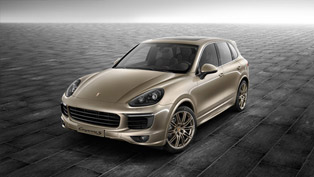Porsche Cayenne – range extended by new diesel engine and hybrid drive
The Porsche Cayenne is one of the success stories of the automotive world. To date, over a quarter of a million examples have been sold since its launch six years ago. In the last financial year 2007/08, 45,478 examples of the Cayenne were sold around the world - more than ever before in a 12 month period.
With over 60 years' experience of building some of the world's best sports cars, Porsche has brought its expertise in engine technology and chassis development to a new segment with the Cayenne with resounding success. Versatility is the spirit of the Cayenne. Every model offers superlative performance on road and track, combined with exceptional capability off-road. Powerful yet practical in every scenario, the Cayenne is very definitely 100% Porsche.
Cayenne Overview The Cayenne range has solid foundations in the form of the 290bhp 3.6-litre V6 petrol Cayenne, starting at £36,801, and the new 3.0-litre V6 Cayenne diesel with standard six-speed Tiptronic S automatic transmission, priced from £39,404. At the pinnacle is the superlative 550bhp 4.8-litre V8 twin-turbocharged Cayenne Turbo S, from £88,869.
With a 385bhp 4.8-litre V8, the Cayenne S offers a broad spread of on and off-road ability, and is priced from £46,343. The Cayenne GTS, with lowered, stiffened suspension, 21" alloy wheels, and a 405bhp version of the 4.8-litre V8, emphasises the exemplary on-road chassis dynamics of the Cayenne. The GTS is priced from £54,085.
Sharing the 4.8-litre V8 of the S and GTS, but adding forced induction for even greater performance, the 500bhp Cayenne Turbo offers an unrivalled blend of power and comfort. Priced from £75,137, the Turbo, with a six-speed Tiptronic S automatic transmission, can accelerate from 0-62mph in 5.1secs. Porsche Active Suspension Management (PASM) is standard, which continuously monitors the damping force on each wheel based on changing road conditions and driving style.
Available to special order, the Turbo S is the ultimate Cayenne, offering a 550bhp version of the twin-turbo 4.8-litre V8. This increase in power lowers the 0-62mph time by 0.3secs, but, remarkably, the average fuel economy is identical to that of the Turbo - 19.0mpg Combined. The Cayenne Turbo and Turbo S are also available with the Porsche Ceramic Composite Brake (PCCB) option, which increases braking performance and offers a like-for-like weight saving of 50% compared to a steel disc.There are two additional bespoke models in the Cayenne range; the special order Transsyberia and the limited edition GTS Porsche Design Edition 3. Costing from £52,783, the Transsyberia commemorates the success of the Cayenne in the gruelling 4,347 mile Rallye Transsyberia from Moscow to Ulaanbaatar in Mongolia in 2007 and 2008. The specification of the car has sporting overtones, with a 405bhp 4.8-litre V8 and Porsche Active Suspension Management (PASM) as standard.
The Cayenne GTS Porsche Design Edition 3, which is limited to just one thousand numbered units worldwide, features styling cues that underline the V8-powered, high-performance personality of this Porsche. The clear imprint of the Porsche Design Studio, based in Zell am See, Austria, which is one of the world leaders in industrial and product design, on this Cayenne model can be seen in the choice of the paintwork colour, Lava Grey Metallic. This is underlined further by design stripes along the side and on the bonnet and 21-inch diameter SportPlus alloy wheels that are also colour co-ordinated to match the special exterior colour. Priced from £64,753, the Cayenne GTS Porsche Design Edition 3 is supplied with a unique Porsche Design Chronograph watch and four-piece luggage set bearing the ‘Porsche Design Edition 3' label.
The new Cayenne Diesel
As is self evident, the desire to constantly improve is a hallmark of Porsche, and the company is used to exploring new territory. The most significant addition to the Cayenne range - the Cayenne Diesel - is a perfect demonstration of this ethos. However, while the Cayenne Diesel may use a different fuel, it certainly shares the same spirit as its petrol-engined relatives.
The introduction of the Cayenne Diesel extends customer choice more widely. The Porsche stake in Volkswagen Group, the world's largest manufacturer of modern diesel engines for passenger cars, has opened up new opportunities to utilise sporty compression-ignition technology under the bonnet of the Cayenne.
The Cayenne Diesel offers a 3.0-litre V6 turbo diesel engine with 240bhp (176kW), an average consumption of 30.4mpg Combined (9.3 litres/100km) and emissions of 244g/km CO2. The spontaneous throttle response and high torque characteristics of this common rail direct fuel injection diesel engine ensure high performance levels that are appropriate for an athletic, all-terrain vehicle such as the Cayenne. The substantial peak torque of 550 Nm between 2,000 - 2,400rpm complements the proven sports-oriented chassis dynamics and provides a high degree of control to offer driving enjoyment typical of Porsche.
With its combination of a sporting drive and efficient, high performance drivetrain, the new Cayenne Diesel complements the rest of the range perfectly. The Cayenne Diesel is on sale now at the 34 Porsche Centres across the UK and Ireland.
With the introduction of the Cayenne Diesel, Porsche is consistently continuing its commitment to reduce fuel consumption in all its cars. As early as spring 2007, Porsche equipped the new generation of the Cayenne with engines featuring petrol direct-injection that consume up to 15 per cent less fuel in real-world driving conditions. Since summer 2008, Porsche has also offered the most recent generation of the 911 sports car with direct-injection petrol engines. A more significant step-change will take place with the introduction of a Cayenne variant with hybrid drive that will exceed 31 mpg, and which will be launched onto the market in the next two years.
The Cayenne Hybrid Hybrid drive by Porsche has a long tradition, with company founder Ferdinand Porsche being acknowledged as the inventor of this drive system. As early as 1900, Ferdinand Porsche developed the Lohner-Porsche Mixte as a serial hybrid vehicle, to use today's terminology, with the car's 15bhp four-cylinder connected directly to an 80 volt dynamo. The electricity generated in this way went either to wheel hub electric motors integrated in the front wheels or to a battery. This vehicle is acknowledged as the world's first hybrid car built in standard production.
Now, joining forces with Volkswagen, Porsche has once again developed a production vehicle with a parallel full hybrid drive for introduction later to the market. Drive power in the Cayenne S Hybrid will come primarily from a supercharged 3.0-litre V6 with Direct Fuel Injection interacting with a 38kW/52bhp electric motor used either as an additional source of power to boost the output of the petrol engine or as the sole drive unit operating on its own. Indeed, a unique function of the Cayenne Hybrid is its ability to smoothly cruise or ‘roll along' with the combustion engine switched off and disengaged at high speeds in the so-called ‘sailing' mode. This practice allows the driver to save fuel at speeds up to 86mph (138km/h), for example when driving on the Autobahn at a relatively consistent speed.
The Cayenne S Hybrid showcases a power-train at the cutting-edge of technology. With forced induction via an engine-driven supercharger, the 2,995cc engine develops 333bhp (245kW) between 5,500 - 7,000rpm. Maximum torque of 440Nm is produced at 2,900rpm and sustained consistently through to 5,300rpm.
In conjunction with the combustion engine, the electric motor serves as a booster for extra power; maximum combined output is 374bhp (275kW) and peak torque of 550Nm at 1,500rpm. Accelerating from rest to 62mph (100km/h) in 6.8secs, the Cayenne S Hybrid thus offers the same sprinting qualities as its sister models with a ‘regular' V8 - hence it proudly bearing the same ‘S' designation.
Masterminded by the powerful Hybrid Manager, the Cayenne S Hybrid will consume less than nine litres per 100km in the New European Drive Cycle (NEDC) equal to CO2 emissions of less than 210g/km - some 20 per cent less than on a conventional vehicle comparable to a Cayenne and with the same kind of power. Based on a six cylinder engine, the Cayenne S Hybrid combines the output of an eight cylinder with the fuel consumption of a four cylinder.
The Cayenne S Hybrid will arrive at Porsche Centres by 2010. Meantime, every new Cayenne customer is able to explore the dynamic attributes of their car, and develop their own skills behind the wheel, courtesy of a Driving Experience Programme at the new Porsche Driving Experience Centre at Silverstone.
A Porsche through and through - under the skin of the Cayenne
Porsche Traction Management (PTM) Standard on every Cayenne is intelligent Porsche Traction Management (PTM), which subdivides the engine power at a ratio of 38:62 between the front and rear wheels to provide a combination of excellent on-road and off-road driving ability. This torque split can be varied by the electronically controlled multi-plate clutch, with up to 100 per cent of power being conveyed to either the front or rear wheels when required.
PTM responds not only to a lack of traction, but also incorporates sensors measuring the speed of the vehicle, its lateral acceleration, the steering angle and movement of the throttle pedal in order to ensure enhanced control under all driving conditions. Furthermore, for rough terrain a low range transfer gearbox can be selected, which also engages a 100 per cent longitudinal differential lock. This fixes the front to rear torque split, and steps down the gear ratio by 2.7:1 for increased speed sensitivity off-road. PTM will still cut in when required, should individual wheels lose contact with the ground.
Porsche Stability Management (PSM) Porsche Stability Management (PSM) featured as standard on the Cayenne constantly interacts with Porsche Traction Management, but only intervenes when the vehicle reaches its physical limits. PSM also masterminds essential systems such as the anti-lock brakes, Anti Slip Regulator (ASR) and Automatic Brake Differential (ABD), but only intervening under extreme physical conditions to enable the car to remain under the control of the driver for as much time as possible.
A sub-function of the anti-lock brake system determines application of the brakes on loose ground, where off-road the ABS will periodically increase wheel slip during the brake cycles. This serves to build up a wedge of snow, sand or fine gravel in front of the wheels, providing an additional brake effect on loose ground and irregular surfaces.
The brake function is further improved by the Brake Assistant and the brake pre-loading option. Recognising the sudden application of the brakes in an emergency, the Brake Assistant immediately builds up the brake pressure required for maximum stopping power and deceleration via the PSM hydraulic control unit. The pre-loading brake function, in turn, generates extra pressure in the system as soon as the driver abruptly takes his foot off the accelerator, thus helping again to shorten stopping distances when applying the brakes. Trailer stability control is enhanced to a new standard and recognises any pendulum, or sway motion, of a trailer and intervenes as required by applying the brakes on the vehicle in the interest of extra stability.
Porsche Ceramic Composite Brakes (PCCB) available as an option The brake system on the Cayenne Turbo stands out clearly not only through its red callipers. To cope with the very significant engine output, the entire brake system has been upgraded with enhanced power assistance. Diameter of the brake discs on the front axle is 368mm (14.49"), diameter at the rear is 358mm (14.09"). The correspondingly larger brake callipers at the front incorporate an additional reinforcement frame bolted at four points to the calliper housing and serving to reinforce the entire brake structure. Porsche Ceramic Composite Brakes (PCCB) are now available as a special, individual feature on the Cayenne, through which Porsche is again underlining the Company's leading position in providing particularly resistant and long-lasting brake discs made of composite ceramic carbon-fibre. The ceramic discs measure 410mm or 16.1" in diameter up front and 370mm or 14.6" in diameter at the rear. The braking effect is generated by six-piston aluminium fixed callipers at the front and four-piston aluminium fixed callipers on the rear wheels. As well as the Cayenne Turbo, PCCB brakes are also available as an option on the Cayenne S, the Cayenne GTS, and the Cayenne Turbo S in combination with 20" and 21" alloy wheels.
Porsche Active Suspension Management (PASM) The Cayenne comes in regular trim with steel spring suspension, with Porsche Active Suspension Management (PASM) with air springs available as an option. In addition to damper control with three different settings, this superior suspension arrangement also enables the driver to lower the body of the vehicle to various levels and stiffen the damper settings to suit a more sporting driving style, or to assist with loading. Conversely, it is also possible to raise body height up to a maximum of 271mm or 10.7" above the ground for tough off-road requirements. A maximum wading depth of 555mm is possible with the air suspension on its highest setting. In this highest suspension setting, the ramp break-over angle is 24.7 degrees, the maximum approach angle is 31.8 degrees and the maximum departure angle is 25.4 degrees.
Porsche Dynamic Chassis Control (PDCC) PASM can be enhanced by Porsche Dynamic Chassis Control (PDCC). Operating in a continuous process with infinite adjustment, this body roll management system limits side roll of the vehicle when cornering, eliminating body roll completely in nearly all driving situations. As a result, the Cayenne offers not only a significant improvement of handling, but also enhanced driving stability and motoring comfort. PDCC is comprised of two active roll-bars with hydraulic swivel motors integrated in lieu of conventional anti-roll bars at the front and rear axles. Thanks to its fast response and maximum operating pressure of up to 180 bar, PDCC is able to build up a counter-force through these active roll-bars and so prevent the body from rolling to the side in a bend.
Sports Button for even greater driving involvement Depending on the level of equipment in the vehicle, the Sports Button influences the throttle pedal control map, the Tiptronic S automatic transmission shift maps, the optional sports exhaust system (on the Cayenne S with Tiptronic S only), PASM damper management and PDCC anti-roll control.
More than ever before, the various models and feature options in the Cayenne range allow the customer to determine and specify the character of the vehicle themselves.
Porsche Driving Experience Centre, Silverstone The world-class facilities at the Porsche Driving Experience Centre are perfect for demonstrating the attributes of the Cayenne. The sports car character of the Cayenne can be explored in depth on the circuits, and the off-road course has been designed to fully exploit the abilities and technology over rugged terrain. The Porsche-designed tracks include steep ascents and side tilts to showcase the axle articulation and grip delivered by the Porsche Traction Management (PTM) all-wheel drive system standard on every Cayenne. A further highlight is the deep water trench that demonstrates the water-wading qualities of the car, putting both the Cayenne and the driver to the test.
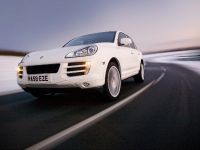
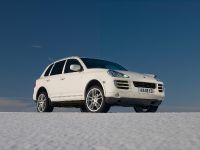
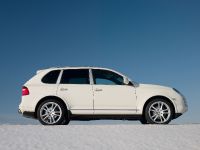
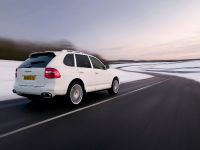
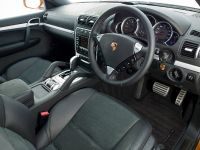
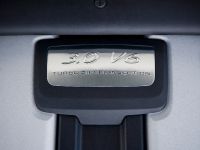
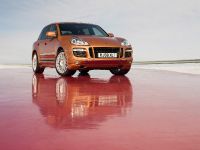
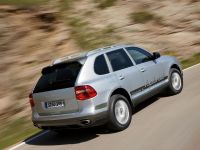


![Porsche Cayenne Turbo S - A Sports Car for Every Occasion [video]](http://www.automobilesreview.com/uploads/2013/11/2013-Porsche-Cayenne-Turbo-S-b.jpg)
